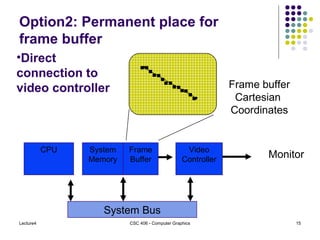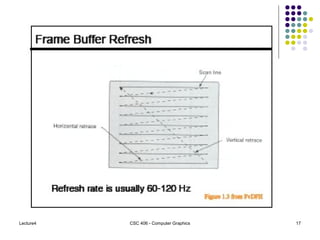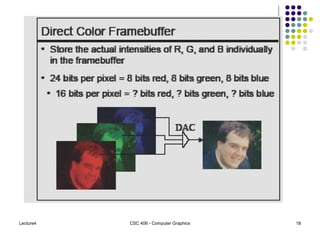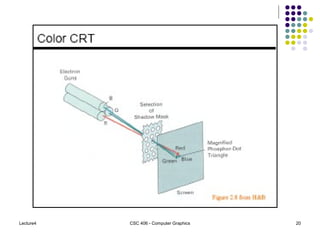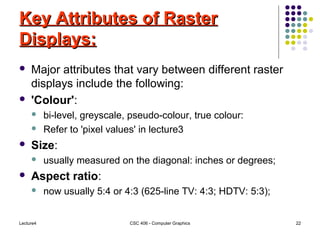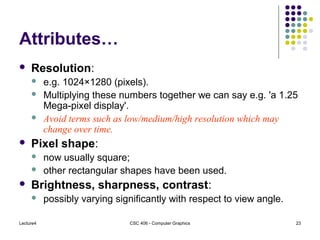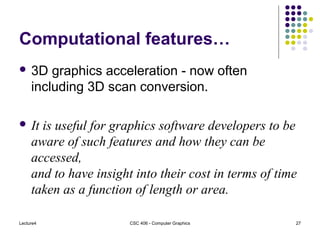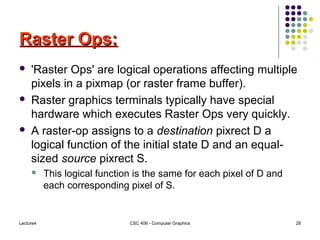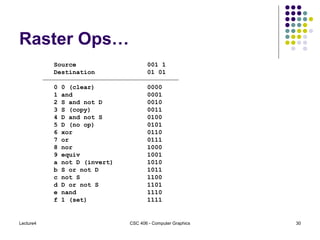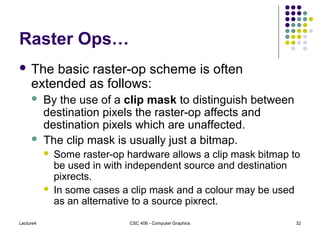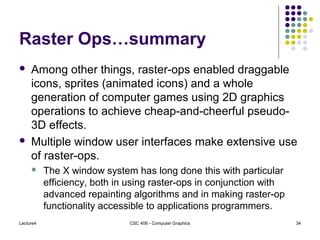lecture4 raster details in computer graphics(Computer graphics tutorials)
- 1. CSC 406 Applied Computer Graphics LECTURE 4:LECTURE 4: Raster Displays - detailsRaster Displays - details
- 2. Daroko blog- Do Not just learn computer graphics an close your computer tab and go away.. APPLY them in real business, Visit Daroko blog for real IT skills applications,androind, Computer graphics,Networking,Programming,IT jobs Types, IT news and applications,blogging,Builing a website, IT companies and how you can form yours, Technology news and very many More ITLecture4 CSC 406 - Computer Graphics 2
- 3. Lecture4 CSC 406 - Computer Graphics 3 Lecture 4:Lecture 4: Scope: Raster memory. Attributes. Raster Ops. Lecture Goals: To examine the memory concepts in raster display. To understand the different attributes of raster desplay.
- 4. Lecture4 CSC 406 - Computer Graphics 4
- 5. Lecture4 CSC 406 - Computer Graphics 5 Raster Memory:Raster Memory: Pixmap: A pixmap is storage for a whole raster of pixel values. Usually a contiguous area of memory, comprising one row (or column) of pixels after another. Bitmap: Technically a bitmap is a pixmap with 1 bit per pixel, i.e. boolean colour values, e.g. for use in a black-and-white display. But 'bitmap' is often misused to mean any pixmap - please try to avoid this!
- 6. Lecture4 CSC 406 - Computer Graphics 6 Raster memory… Pixrect: A pixrect is any 'rectangular area' within a pixmap. A pixrect thus typically refers to a series of equal- sized fragments of the memory within a pixmap, one for each row (or column) of pixels.
- 7. Lecture4 CSC 406 - Computer Graphics 7 Frame Buffer: Frame buffers are often special two-ported memory devices ('video memory') with one port for writing and another for concurrent reading. Alternatively they can be part of the ordinary fast RAM of a computer, which allows them to be extensively reconfigured by software.
- 8. Lecture4 CSC 406 - Computer Graphics 8
- 9. Lecture4 CSC 406 - Computer Graphics 9 Frame buffer… Defn: A frame buffer is a video output device that drives a video display from a memory buffer containing a complete frame of data. The information in the buffer typically consists of color values for every pixel (point that can be displayed) on the screen.
- 10. Lecture4 CSC 406 - Computer Graphics 10 Frame buffer… Color values are commonly stored in: 1-bit monochrome, 4-bit palettized, 8-bit palettized, 16-bit highcolor and 24-bit truecolor formats. An additional alpha channel is sometimes used to retain information about pixel transparency.
- 11. Lecture4 CSC 406 - Computer Graphics 11 Frame buffer… The total amount of the memory required to drive the frame buffer depends on the resolution of the output signal, and on the color depth and palette size. Frame buffers differ significantly from the vector graphics displays that were common prior to the advent of the frame buffer.
- 12. Lecture4 CSC 406 - Computer Graphics 12 Frame buffer… With a vector display, only the vertices of the graphics primitives are stored. The electron beam of the output display is then commanded to move from vertex to vertex, tracing an analog line across the area between these points.
- 13. Lecture4 CSC 406 - Computer Graphics 13 Frame buffer… With a framebuffer, the electron beam (if the display technology uses one) is commanded to trace a left-to-right, top-to-bottom path across the entire screen, the way a television renders a broadcast signal. At the same time, the color information for each point on the screen is pulled from the frame buffer, creating a set of discrete picture elements (pixels).
- 14. Lecture4 CSC 406 - Computer Graphics 14 Option1: Frame buffer is anywhere in system memory System Bus CPU Video Controller System Memory Monitor Frame buffer Cartesian Coordinates
- 15. Lecture4 CSC 406 - Computer Graphics 15 Option2: Permanent place for frame buffer System Bus CPU Video Controller System Memory Monitor Frame buffer Cartesian Coordinates Frame Buffer •Direct connection to video controller
- 16. Lecture4 CSC 406 - Computer Graphics 16 Frame buffer… With respect to color displays, there are two types of frame buffers: Direct color frame buffer Color lookup frame buffer
- 17. Lecture4 CSC 406 - Computer Graphics 17
- 18. Lecture4 CSC 406 - Computer Graphics 18
- 19. Lecture4 CSC 406 - Computer Graphics 19
- 20. Lecture4 CSC 406 - Computer Graphics 20
- 21. Lecture4 CSC 406 - Computer Graphics 21 Raster memory… In a bit-mapped display, the display processor refreshes the screen 25 or more times per second, a line at a time, from a pixmap termed its frame buffer. In each refresh cycle, each pixel's colour value is 'copied' from the frame buffer to the screen. Additional raster memory may exist 'alongside' that for colour values. For example there may be an 'alpha channel' (transparency values) a z-buffer (depth values for hidden object removal), or an a-buffer (combining both ideas).
- 22. Lecture4 CSC 406 - Computer Graphics 22 Key Attributes of RasterKey Attributes of Raster Displays:Displays: Major attributes that vary between different raster displays include the following: 'Colour': bi-level, greyscale, pseudo-colour, true colour: Refer to 'pixel values' in lecture3 Size: usually measured on the diagonal: inches or degrees; Aspect ratio: now usually 5:4 or 4:3 (625-line TV: 4:3; HDTV: 5:3);
- 23. Lecture4 CSC 406 - Computer Graphics 23 Attributes… Resolution: e.g. 1024×1280 (pixels). Multiplying these numbers together we can say e.g. 'a 1.25 Mega-pixel display'. Avoid terms such as low/medium/high resolution which may change over time. Pixel shape: now usually square; other rectangular shapes have been used. Brightness, sharpness, contrast: possibly varying significantly with respect to view angle.
- 24. Lecture4 CSC 406 - Computer Graphics 24 Attributes… Speed, interlacing: now usually 50 Hz or more and flicker-free to most humans; Computational features, as discussed next...
- 25. Lecture4 CSC 406 - Computer Graphics 25 Computational features:Computational features: Since the 1970s, raster display systems have evolved to offer increasingly powerful facilities, often packaged in optional graphics accelerator boards or chips. These facilities have typically consisted of hardware implementation or acceleration of computations which would otherwise be coded in software, such as:
- 26. Lecture4 CSC 406 - Computer Graphics 26 Computational features… Raster-ops: fast 2D raster-combining operations explained next; 2D scan conversion, i.e. creating raster images required by 2D drawing primitives such as: 2D lines, e.g. straight/circular/elliptical lines, maybe spline curves (based on several points); 2D coloured areas, e.g. polygons or just triangles, possibly with colour interpolation; Text (often copied from rasterised fonts using raster-ops);
- 27. Lecture4 CSC 406 - Computer Graphics 27 Computational features… 3D graphics acceleration - now often including 3D scan conversion. It is useful for graphics software developers to be aware of such features and how they can be accessed, and to have insight into their cost in terms of time taken as a function of length or area.
- 28. Lecture4 CSC 406 - Computer Graphics 28 Raster Ops:Raster Ops: 'Raster Ops' are logical operations affecting multiple pixels in a pixmap (or raster frame buffer). Raster graphics terminals typically have special hardware which executes Raster Ops very quickly. A raster-op assigns to a destination pixrect D a logical function of the initial state D and an equal- sized source pixrect S. This logical function is the same for each pixel of D and each corresponding pixel of S.
- 29. Lecture4 CSC 406 - Computer Graphics 29 Raster Ops… All bits in a destination pixel are processed in parallel. So each bit in a destination pixrect D is assigned the specified logical function of its initial value and the value of the corresponding bit in a congruent source pixrect S. Or S may be a bitmap; then the same source bit is applied with each bit of a destination pixel. There are 16 possible 'logical functions' (boolean operators) which may be used, See truth table on next slide:
- 30. Lecture4 CSC 406 - Computer Graphics 30 Raster Ops… Source 001 1 Destination 01 01 0 0 (clear) 0000 1 and 0001 2 S and not D 0010 3 S (copy) 0011 4 D and not S 0100 5 D (no op) 0101 6 xor 0110 7 or 0111 8 nor 1000 9 equiv 1001 a not D (invert) 1010 b S or not D 1011 c not S 1100 d D or not S 1101 e nand 1110 f 1 (set) 1111
- 31. Lecture4 CSC 406 - Computer Graphics 31 Raster Ops… The functions commonly used are 0 (clear), 3 (copy), 6 (xor), a (invert) and f (set), especially copy. Scrolling is generally done by repeated use of the copy function such that the source and destination pixrects are overlapping regions of the frame buffer. Another frequent use of the copy function is to save a copy of part of a background image before drawing a moving object over it, then copying back the saved image and repeating this process for further positions and states of the moving object.
- 32. Lecture4 CSC 406 - Computer Graphics 32 Raster Ops… The basic raster-op scheme is often extended as follows: By the use of a clip mask to distinguish between destination pixels the raster-op affects and destination pixels which are unaffected. The clip mask is usually just a bitmap. Some raster-op hardware allows a clip mask bitmap to be used in with independent source and destination pixrects. In some cases a clip mask and a colour may be used as an alternative to a source pixrect.
- 33. Lecture4 CSC 406 - Computer Graphics 33 Raster Ops… By the use of a plane mask to limit the planes of a frame buffer that will be affected. A plane mask is a pixel value in which (usually) 1's specify affected planes and 0's specify unaffected planes. Thus pixmaps with n-bit pixel values can be treated as having n different 'bit-planes'. For example an 8-bit-pixel pixmap can be used to hold two 4-bit-pixel images or four 2-bit-pixel images.
- 34. Lecture4 CSC 406 - Computer Graphics 34 Raster Ops…summary Among other things, raster-ops enabled draggable icons, sprites (animated icons) and a whole generation of computer games using 2D graphics operations to achieve cheap-and-cheerful pseudo- 3D effects. Multiple window user interfaces make extensive use of raster-ops. The X window system has long done this with particular efficiency, both in using raster-ops in conjunction with advanced repainting algorithms and in making raster-op functionality accessible to applications programmers.
- 35. Lecture4 CSC 406 - Computer Graphics 35 Next Lecture… Scan conversion. Device independence/ normalization.















